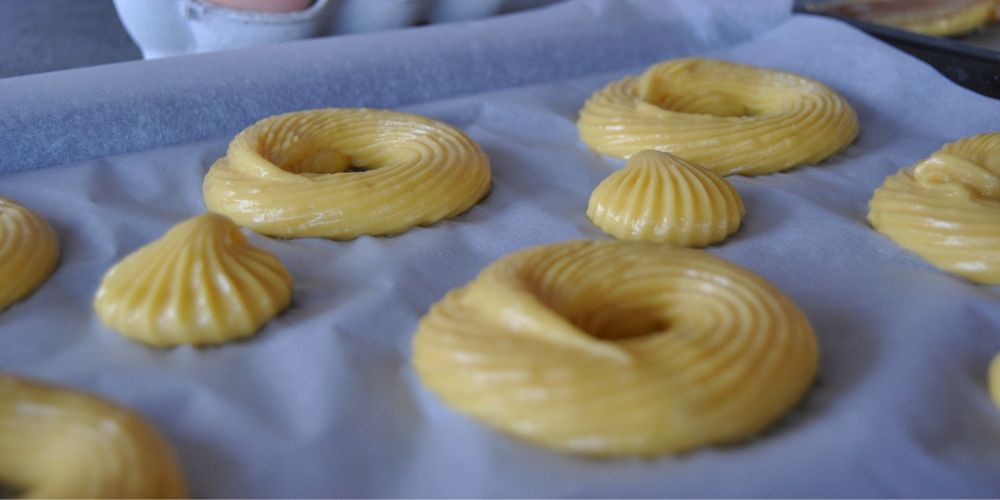"Naples invented them, all of Italy licked its fingers", writes Giovanni Bideri in his book "Passeggiata per Napoli e contorni" in the mid-19th century.
Zeppole di San Giuseppe, were invented in Naples in the 1800s but soon spread throughout Italy.
Each region has its own variations and different typical names, but from North to South they are the dessert par excellence of Father's Day, which in Italy is celebrated on March 19.
They are a soft, light dough made of flour, sugar, eggs and butter - strictly fried! - and enriched with custard, dusted with powdered sugar and decorated with sour cherries in syrup.
St. Joseph's Day is approaching, so all you have to do is buy all the ingredients and get busy making Neapolitan Zeppole!
On the other hand, if you are in Naples, what could be better than enjoying some mouth-watering Zeppole ready-made in one of the best pastry shops in town?
Buy your Naple Pass here!
Zeppole di San Giuseppe: the origins between history and legend

Zeppole di San Giuseppe
As with any recipe whose origin dates back to the old past, there are several legends about the birth of Zeppole di San Giuseppe: it seems, in fact, that the origins of this delicacy date back as far as 500 B.C., when fragrant wheat fritters were enjoyed in Rome and fried in plenty of boiling lard.
According to another story, it seems that the origins of zeppole can be found in the peasant tradition of celebrating the end of winter and the beginning of spring on March 19 by lighting bonfires and eating pancakes with a rolled shape covered in honey.
A religious legend, on the other hand, has it that the birth of zeppole dates as far back as the Escape of the Holy Family to Egypt when St. Joseph, in order to support Mary and Jesus, also became a traveling fryer, selling sweet pancakes on the streets.
This seems to be where the tradition of celebrating St. Joseph's feast day with zeppole and the tradition of street zeppolari in Naples, who used to fry directly in the street, in front of their stores, and serve zeppole to passersby, come from.
Even Goethe, visiting Naples in the late 1700s, wrote, "Today was also the feast of St. Joseph, patron saint of all frittaroli, that is, sellers of fried dough... "
Like any dessert, the version that in the 1700s it was the nuns who gave the zeppole the shape we know today cannot be missed: it was perhaps born in the monastery of San Basilio in San Gregorio Armeno or in that of Santa Patrizia, or by the nuns of the Cross of Lucca or those of the Splendor...
But the history of Zeppole di San Giuseppe officially began in 1837, when the Neapolitan gastronome Ippolito Cavalcanti, Duke of Buonvicino, included the first official recipe in the Neapolitan language in his historic treatise "La Cucina teorico pratica" (The Theoretical-Practical Cuisine).
According to another tradition, it was Don Pasquale Pintauro, a Neapolitan pastry chef famous for inventing sfogliatelle, who created 'zeppole bignè' in 1840 by enriching the original dough with eggs, lard and flavorings, then proceeding with the characteristic double frying, first in oil and then in lard, and filling it with a rich and tasty custard topped with a juicy black cherry in syrup.
Visit all the attractions in Naples with this ticket!The recipe for making them at home

Zeppole di San Giuseppe: the dough
The recipe for Zeppole di San Giuseppe is a bit long because it consists of several steps of preparation, but it is quite simple and you will look forward to this mouth-watering dessert!
First dedicate yourself to the dough for the base, the so-called choux pastry (or pasta sciù, in Neapolitan) for which you will need water, eggs, flour, butter and a pinch of salt:
In a saucepan, melt the butter in water and salt. Remove from the heat and add the sifted flour, stirring with a whisk. Put the saucepan back on the heat and cook, stirring constantly until the mixture pulls away from the sides. Let it cool. At this point add the eggs, one at a time, waiting until the first has been well incorporated before adding the second.
When you get a smooth, sticky mixture, fill a sac-à-poche with a star-shaped nozzle and, on a baking sheet lined with parchment paper, form crowns.
Fry in plenty of boiling oil, taking care to turn them over so they cook on the other side as well. A total of 5-6 minutes will be enough. Once ready and well browned, drain them with a skimzeppole-di-san-giuseppe-ricettamer and leave them on a sheet of paper towel to drain excess oil.
Once the choux pastry is ready, turn to the preparation of the custard.
You will need: eggs (the yolks), sugar, milk, a little flour and the grated peel of a lemon.
Start by working the yolks with the sugar in a saucepan. Gradually add the flour, continuing to stir until the mixture is smooth. Pour the boiling milk in a trickle, continuing to stir. Put the saucepan on the stove, and while continuing to stir, cook until the mixture looks ready.
Transfer the custard to a sac-à-poche with a star-shaped nozzle and spread it over the zeppole sprinkled with powdered sugar.
Finish by garnishing with sour cherries in syrup and enjoy!
Zeppole di San Giuseppe: the origins of the name and variations in southern Italy

Zeppole di San Giuseppe: variations
On the origin of the name 'Zeppola' there are differing opinions:
Some believe that "zeppola" derives from "serpula," or snake, because of the typical shape of the cake resembling a snake twisted on itself.
According to others, the term would derive from 'zeppa' -from the Latin cippus -that is, the small piece of wood that carpenters use to correct small defects in the balance of furniture. In this case there would also be a reference to St. Joseph, carpenter par excellence.
The last hypothesis is closely linked to the city of Naples, where the name would be a tribute to the legendary artisan Zi' Paolo, a Neapolitan fryer, the inventor of the street zeppola.
Just as there are different theories about the origin of the name, there are also different versions of Zeppole di San Giuseppe in southern Italy:
The recipes closest to the Neapolitan one are the Molise, the Abruzzese and the Apulian ones also because of the strong veneration of the Feast of St. Joseph, which is very much felt in these places.
In the Sicilian and Calabrian versions of zeppole, custard is substituted for ricotta cheese decorated with dried fruit grains or candied fruit.
In some regions of Italy, on the other hand, Zeppole are the typical Carnival dessert: in the Marche and Sardinia, in fact, they are fried doughnuts or balls flavored with the typical local liqueurs, aniseed and brandy.
About the author
Written on 13/02/2024



Mariateresa Bonanotte
Zeppole di San Giuseppe are the signature dessert of Father's Day. Find out with us the history and recipe and why they are eaten on March 19!